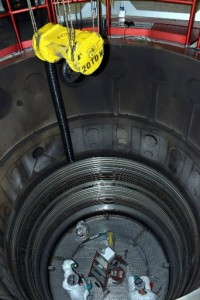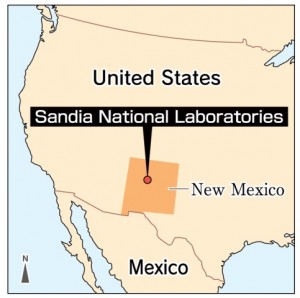Hiroshima Asks: Toward the 70th Anniversary of the Atomic Bombing: U.S. laboratory gives newspaper access to Z machine
Dec. 26, 2014
Equipment used to test performance of nuclear weapons
Goal of deterrence capacity stressed
by Yumi Kanazaki, Staff Writer
This month the Sandia National Laboratories in New Mexico gave the Chugoku Shimbun access to its Z Pulsed Power Facility, commonly known as the Z machine, which is used to test the performance of nuclear weapons. It was the first time a member of the news media in Hiroshima entered the world’s most advanced testing facility, which is crucial for the maintenance of nuclear weapons. The person who gave the tour said that the facility was intended to maintain nuclear deterrence capability and stressed that it benefited Japan, an ally of the United States.
The Z machine uses high magnetic fields associated with electrical currents to produce tremendous amounts of energy and can generate the most powerful X-rays in the world. By creating conditions of extreme temperature and pressure approaching those of a nuclear explosion, without causing an explosion or achieving criticality, it can be used to check the behavior of tiny amounts of plutonium in order to determine how the material will react to degradation.
The laboratories in Sandia are administered by the National Nuclear Security Administration (NNSA), an agency under the U.S. Department of Energy. The predecessor of the current facility was established by the NNSA in 1985. The laboratory’s equipment underwent a complete upgrade in 2007 as part of the measures to maintain the performance of nuclear weapons under the Stockpile Stewardship Program (SSP).
Thirteen types of tests are conducted under the SSP, including sub-critical nuclear tests carried out at an underground nuclear testing facility in Nevada. Four times a year the NNSA announces what tests have been conducted. Under the administration of President Barack Obama, who, in a speech in Prague in 2009 declared his intention to “seek the peace and security of a world without nuclear weapons,” the U.S. has already carried out 12 plutonium tests with the Z machine and four sub-critical nuclear tests. These tests have sparked protests in Hiroshima and Nagasaki.
In early November it was announced that a total of two tests had been conducted with the Z machine in September and October. In response, on November 4 Hiroshima Mayor Kazumi Matsui sent a letter of protest to the president via the U.S. embassy in Tokyo. In his letter the mayor stated that the tests indicated the intention of the U.S. to continue to possess nuclear weapons and were totally unacceptable. Organizations of atomic bomb survivors and groups opposing nuclear weapons conducted sit-ins in front of the Cenotaph for the A-bomb Victims in Peace Memorial Park on November 3 and 5.
With regard to the letters of protest, an official at the laboratories in Sandia said he did not always read them but that he was aware of Hiroshima’s concern. With regard to the sit-ins in Hiroshima to protest the plutonium tests with the Z machine, the official said that the U.S. had an obligation to Japan and its other allies to guarantee the nation’s nuclear deterrence capacity.
Meanwhile the Japanese government continues to rely on the nuclear umbrella of the U.S. for its security. At a press conference in March 2013 following the revelation of plutonium tests using the Z machine, Chief Cabinet Secretary Yoshihide Suga said, “We are aware that the tests were conducted to maintain and assess the safety and efficacy of stockpiled nuclear weapons. There was no nuclear explosion in conjunction with the tests and [the government] is not considering lodging a protest.”
(Originally published on December 22, 2014)
Goal of deterrence capacity stressed
by Yumi Kanazaki, Staff Writer
This month the Sandia National Laboratories in New Mexico gave the Chugoku Shimbun access to its Z Pulsed Power Facility, commonly known as the Z machine, which is used to test the performance of nuclear weapons. It was the first time a member of the news media in Hiroshima entered the world’s most advanced testing facility, which is crucial for the maintenance of nuclear weapons. The person who gave the tour said that the facility was intended to maintain nuclear deterrence capability and stressed that it benefited Japan, an ally of the United States.
The Z machine uses high magnetic fields associated with electrical currents to produce tremendous amounts of energy and can generate the most powerful X-rays in the world. By creating conditions of extreme temperature and pressure approaching those of a nuclear explosion, without causing an explosion or achieving criticality, it can be used to check the behavior of tiny amounts of plutonium in order to determine how the material will react to degradation.
The laboratories in Sandia are administered by the National Nuclear Security Administration (NNSA), an agency under the U.S. Department of Energy. The predecessor of the current facility was established by the NNSA in 1985. The laboratory’s equipment underwent a complete upgrade in 2007 as part of the measures to maintain the performance of nuclear weapons under the Stockpile Stewardship Program (SSP).
Thirteen types of tests are conducted under the SSP, including sub-critical nuclear tests carried out at an underground nuclear testing facility in Nevada. Four times a year the NNSA announces what tests have been conducted. Under the administration of President Barack Obama, who, in a speech in Prague in 2009 declared his intention to “seek the peace and security of a world without nuclear weapons,” the U.S. has already carried out 12 plutonium tests with the Z machine and four sub-critical nuclear tests. These tests have sparked protests in Hiroshima and Nagasaki.
In early November it was announced that a total of two tests had been conducted with the Z machine in September and October. In response, on November 4 Hiroshima Mayor Kazumi Matsui sent a letter of protest to the president via the U.S. embassy in Tokyo. In his letter the mayor stated that the tests indicated the intention of the U.S. to continue to possess nuclear weapons and were totally unacceptable. Organizations of atomic bomb survivors and groups opposing nuclear weapons conducted sit-ins in front of the Cenotaph for the A-bomb Victims in Peace Memorial Park on November 3 and 5.
With regard to the letters of protest, an official at the laboratories in Sandia said he did not always read them but that he was aware of Hiroshima’s concern. With regard to the sit-ins in Hiroshima to protest the plutonium tests with the Z machine, the official said that the U.S. had an obligation to Japan and its other allies to guarantee the nation’s nuclear deterrence capacity.
Meanwhile the Japanese government continues to rely on the nuclear umbrella of the U.S. for its security. At a press conference in March 2013 following the revelation of plutonium tests using the Z machine, Chief Cabinet Secretary Yoshihide Suga said, “We are aware that the tests were conducted to maintain and assess the safety and efficacy of stockpiled nuclear weapons. There was no nuclear explosion in conjunction with the tests and [the government] is not considering lodging a protest.”
(Originally published on December 22, 2014)









